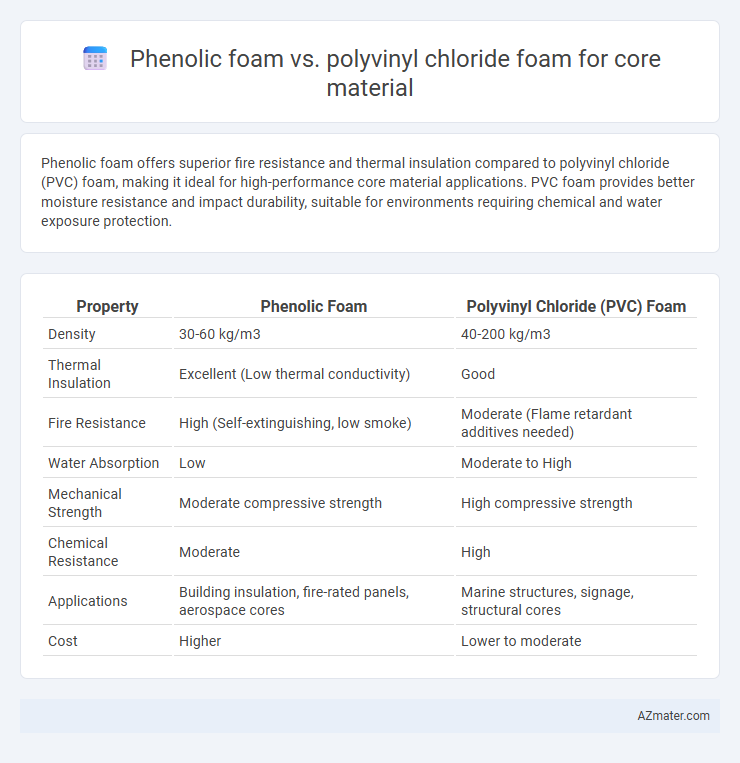Phenolic foam offers superior fire resistance and thermal insulation compared to polyvinyl chloride (PVC) foam, making it ideal for high-performance core material applications. PVC foam provides better moisture resistance and impact durability, suitable for environments requiring chemical and water exposure protection.
Table of Comparison
| Property | Phenolic Foam | Polyvinyl Chloride (PVC) Foam |
|---|---|---|
| Density | 30-60 kg/m3 | 40-200 kg/m3 |
| Thermal Insulation | Excellent (Low thermal conductivity) | Good |
| Fire Resistance | High (Self-extinguishing, low smoke) | Moderate (Flame retardant additives needed) |
| Water Absorption | Low | Moderate to High |
| Mechanical Strength | Moderate compressive strength | High compressive strength |
| Chemical Resistance | Moderate | High |
| Applications | Building insulation, fire-rated panels, aerospace cores | Marine structures, signage, structural cores |
| Cost | Higher | Lower to moderate |
Introduction to Core Materials in Composite Structures
Phenolic foam and polyvinyl chloride (PVC) foam are commonly used core materials in composite structures, each offering distinct mechanical and thermal properties. Phenolic foam provides excellent fire resistance, low smoke emission, and high compressive strength, making it ideal for aerospace and marine applications where safety and durability are critical. PVC foam is valued for its superior impact resistance, good dimensional stability, and ease of fabrication, frequently employed in automotive and construction industries for lightweight insulation and structural support.
Overview of Phenolic Foam
Phenolic foam is a highly efficient core material known for its excellent fire resistance, low smoke emission, and superior thermal insulation properties, making it ideal for building panels and transportation applications. Its closed-cell structure provides exceptional flame retardancy and dimensional stability under high-temperature conditions. Compared to polyvinyl chloride (PVC) foam, phenolic foam offers enhanced fire safety and lower toxicity, though it generally has lower mechanical strength and flexibility.
Overview of Polyvinyl Chloride (PVC) Foam
Polyvinyl chloride (PVC) foam is a lightweight, closed-cell core material widely used in sandwich panel constructions due to its excellent mechanical strength and chemical resistance. Its thermal insulation properties, combined with good moisture resistance and ease of fabrication, make PVC foam a preferred choice in marine, automotive, and construction industries. Compared to phenolic foam, PVC foam offers greater impact resistance and dimensional stability under varying environmental conditions.
Mechanical Properties Comparison
Phenolic foam offers superior fire resistance and higher compressive strength compared to polyvinyl chloride (PVC) foam, making it ideal for structural core applications requiring enhanced mechanical stability. PVC foam, while lighter and more flexible, exhibits lower modulus and reduced impact resistance, limiting its use in load-bearing panels. The choice between phenolic and PVC foam cores depends on the specific mechanical property requirements such as shear strength, stiffness, and durability under thermal stress.
Fire Resistance and Thermal Performance
Phenolic foam exhibits superior fire resistance due to its low smoke emission, self-extinguishing properties, and high char formation compared to Polyvinyl chloride (PVC) foam, which tends to release more toxic gases when exposed to flames. Thermal performance of phenolic foam is enhanced by its low thermal conductivity, making it more efficient for insulation in extreme temperature conditions than PVC foam, which generally has higher thermal conductivity. These characteristics make phenolic foam a preferred core material in applications where fire safety and thermal insulation are critical.
Weight and Density Considerations
Phenolic foam exhibits lower density, typically around 32-64 kg/m3, offering lightweight properties ideal for core materials in insulation and structural applications. Polyvinyl chloride (PVC) foam generally has a higher density range of 50-200 kg/m3, resulting in increased weight but enhanced mechanical strength and durability. Weight considerations favor phenolic foam for applications requiring minimal mass, while PVC foam suits scenarios demanding robust impact resistance and dimensional stability.
Chemical Resistance and Durability
Phenolic foam exhibits superior chemical resistance compared to polyvinyl chloride (PVC) foam, effectively withstanding exposure to acids, alkalis, and solvents without significant degradation. PVC foam offers moderate chemical resistance but tends to soften or degrade when exposed to aggressive chemicals over time. Durability of phenolic foam is enhanced by its rigidity and fire-retardant properties, making it ideal for long-term structural core applications, whereas PVC foam provides good impact resistance but may suffer from reduced mechanical integrity under prolonged chemical exposure.
Cost Analysis and Availability
Phenolic foam typically costs more than polyvinyl chloride (PVC) foam due to its superior fire resistance and thermal insulation properties, resulting in higher manufacturing expenses. PVC foam is widely available and produced in larger quantities, making it a more economical choice for core materials in construction and insulation applications. The cost-effectiveness of PVC foam combined with its ready availability often leads to its preference despite the enhanced performance characteristics of phenolic foam.
Environmental Impact and Sustainability
Phenolic foam offers superior fire resistance and lower smoke emission compared to polyvinyl chloride (PVC) foam, making it a safer environmental choice for core materials in construction and insulation. Phenolic foam is often praised for its reduced toxicity, lower global warming potential, and higher recyclability, whereas PVC foam production involves chlorine compounds that can release hazardous dioxins during manufacturing and disposal. In terms of sustainability, phenolic foam's longer lifespan and improved thermal insulation contribute to energy efficiency and reduced carbon footprint over its service life compared to PVC foam.
Applications and Industry Use Cases
Phenolic foam is widely used in fire-resistant applications such as insulation for commercial buildings, HVAC systems, and shipbuilding due to its excellent thermal stability and low smoke emission. Polyvinyl chloride (PVC) foam is preferred in the automotive, marine, and construction industries for core materials because of its superior moisture resistance, mechanical strength, and ease of fabrication. Both foams serve critical roles in sandwich panels and composite structures, where phenolic foam excels in fire safety, while PVC foam offers durability and versatility in harsh environments.

Infographic: Phenolic foam vs Polyvinyl chloride foam for Core material
 azmater.com
azmater.com